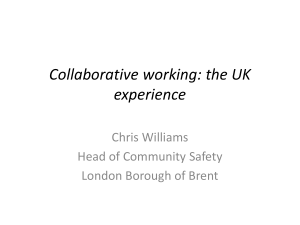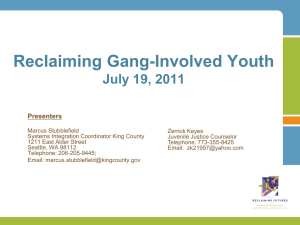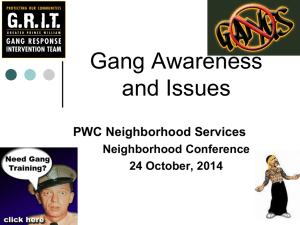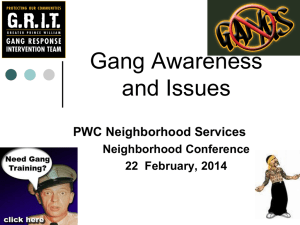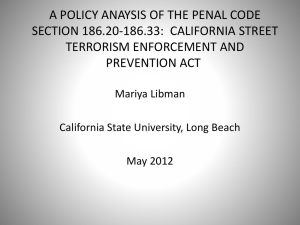The Effects of Peer Pressure on Gang Involvement HEHD 804
advertisement
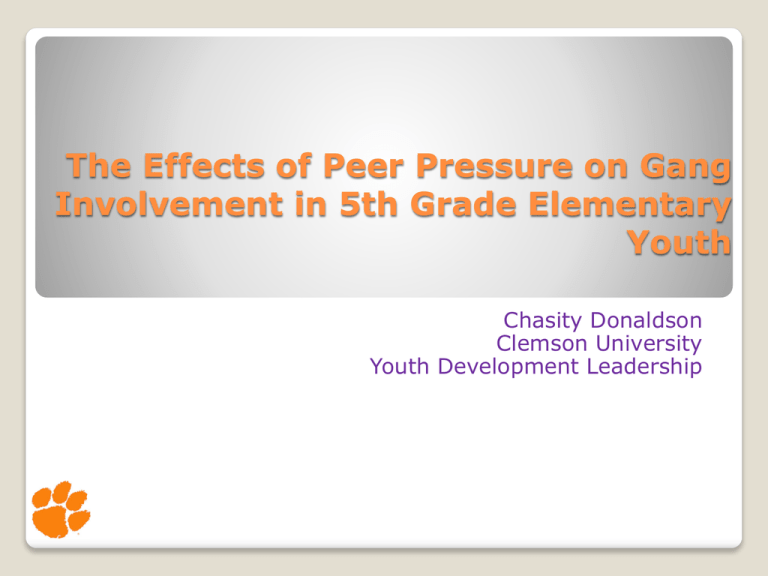
The Effects of Peer Pressure on Gang Involvement in 5th Grade Elementary Youth Chasity Donaldson Clemson University Youth Development Leadership Fast Facts: The 2009 National Youth Gang Survey reports: Youth gang activity has increased to 34.5% in comparison to 32.4% in 2008 Estimated 28,000 gangs 731,000 gang members /3,500 jurisdictions Gangs are male dominated Female gang members are on the rise 96% of all gang homicides are in larger cities Community Collaboration Emphasizes positive youth development by partnering with local agencies ,citizens and local, state, and federal law enforcement in gang prevention and intervention in Charlotte-Mecklenburg What is Being Done? Problem Peer pressure, along with other factors, is an element that weighs heavily on the increase in the numbers of youth who are involved with gangs. Purpose To evaluate which type of decision making educational facilitation: Consequences of Bad Choices; Media and Violence; Gangs; Presentation Follow-Up has the greatest impact on reducing negative peer pressure for gang involvement among 5th grade elementary students in Charlotte – Mecklenburg Schools, who participate in the Dangers Involved with Gangs program Who will Participate? 5th grade elementary students What impact does gang prevention have on peer pressure on 5th grade elementary students? What are the programming factors that contribute to positive decision making to reduce gang influence among elementary 5th grade youth What is the correlation between early gang intervention at the elementary level and peer pressure? What is the correlation between early gang intervention at the elementary level and views about gang involvement? How do 5th grade elementary students describe their experiences with gangs Research Questions: Literature Review: Factors that are overlooked in literature that directly limits gang and violence programming Similarities between attitudes towards violence and crime between adolescents who are from disadvantages neighborhoods in other parts of the world and in the United States The correlation between the increase in female gang involvement and peer pressure and dysfunctional families Methodology Quantitative Data Analysis and Reporting Survey Qusai Experiment Modified Pilot testing Cross sectional Frequencies Percentages Central Tendency (mean, median, and mode) Measures of Dispersion (range and standard deviation) Delimitations: Only to 5th grade elementary students in low socioeconomic areas Only to low socioeconomic areas Only youth and not parents others who may have a major influential factors Study Implications: Conclusions from this study will increase the knowledge of gang reductionintervention programs. This knowledge will provide insight pertaining to the largest risk factors of elementary youth that pose significant challenges to gang reduction programs and that work against positive youth development Klein, M. (2011). Comprehensive Gang Reduction Violence Programs. Criminology & Public Policy Vol. 10 Issue 4, p1037-1044, 8p. Retrieved from: http://web.ebscohost.com.libproxy.clemson.edu/ehost/ Walker-Barnes,C; Mason,C. (2001). Perceptions of Risk Factors for Female Gang Involvement among African American and Hispanic Women. Youth & Society. Vol. 32 Issue 3, p303, 34p. Retrieved from: http://web.ebscohost.com.libproxy.clemson.edu/ehost/ Zdun, S. (2008). Violence in Street Culture: Cross-Cultural Comparison of Youth Groups and Criminal Gangs. New Directions for Youth Development Vol. 2008 Issue 119, p39-54, 16p Krejcie, R.V., Morgan, D. W. (1970). “Determining Sample Size for Research Activities”. Educational and Psychological Measurement. Retrieved from: www.fns.usda.gov/fdd/processing/info/SalesVerificationTable.doc References:


